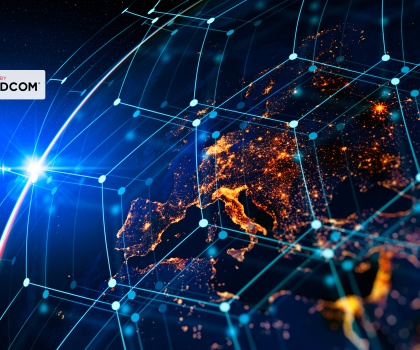A Conversation with TELUS CTO Ibrahim Gedeon
Connected by Broadcom
Broadcom is connecting everything. Our technology — both semiconductor and infrastructure software—powers the most complex IT environments in the world and touches everyday life — from the latest mobile and home devices to the Cloud, to service provider networks, to software and critical infrastructure. The Connected by Broadcom interview series features discussions with leaders who partner with Broadcom to take their business to the next level.
Ibrahim Gedeon is the Chief Technology Officer (CTO) for TELUS, one of Canada’s largest wireless providers, where he charts the technology course for a company with a huge presence in wireless and wireline voice and data services, as well as internet access. TELUS also offers entertainment, video, and security solutions to consumers, businesses, and governments across Canada. The company’s offerings even extend beyond telecommunications, to digital health solutions, such as virtual care and health monitoring, agriculture and IoT.
It wasn’t always so. In the early 2000s, TELUS expanded beyond telecom to deliver IP and internet services. At the time, Ibrahim recalled how critics were skeptical but the numbers speak to the wisdom of that decision: today, TELUS is a dynamic, world-leading communications technology company with more than $18 billion in annual revenue and 18 million customer connections. It’s quite the growth trajectory from the $6.4 billion it posted in 2000. I chatted with Ibrahim recently to learn more about the company and discuss the future of broadband and network infrastructure for our “Connected by Broadcom'' series. Here are highlights from our conversation:
CTO Corporate Vision
A CTO is one of the most important positions in a technology company, especially at a telecommunications firm – Ibrahim jokes that he keeps reminding his boss that it's the most important role. But more seriously, he views his role as being responsible for vetting new technologies that have transformative value and that TELUS can deploy to build new services and propel the company’s business. At the same time, TELUS contributes to the wider technology ecosystem – both in academia and in partnership with the government – to develop better technologists, computer scientists and engineers. Ibrahim described a moral responsibility for large companies to invest in the public sector to help close the digital divide and described how it’s in their enlightened self-interest for companies that are making money to give back to their communities. “You would not believe how excited my team members are to do work that makes the community safer or results in better safety or health outcomes,” he said. “That sparks a lot of revenue, but that's not the main motivation.”
Investing for the Future
In 2012, TELUS began replacing its copper lines to the home with fiber connections, a move that Ibrahim noted has cut down on maintenance and led to vastly improved broadband service for customers. At the same time, TELUS invested in providing better Wi-Fi connectivity – something that has helped create a service that is “reliable, solid, and affordable.” Looking back on the decision, Ibrahim noted that it was worth making these upfront investments because otherwise, each time a customer called a service provider, they would get charged a couple of hundred dollars for a technician house call. “I think it's critical that we invest in that extra $20, $30, $40, $50 to avoid that $200 dissatisfied customer,” he said.
Wi-Fi 7
With Wi-Fi 7 on the horizon – the upgrade is expected to hit the market early next year – Ibrahim expects the new standard will further improve service. He likened the scenario to the transition from 4G to 5G, albeit with more speeds and versatility.
Gauging AI’s Impact
As a technologist, Ibrahim is responsible for figuring out how to harness recent advancements in artificial intelligence. He said it could be particularly useful when it comes to things such as troubleshooting, security patches, and upgrades – boring but crucial tasks for enterprises and even SMBs that may be hard to track manually. Yet while he sees “unbelievable” opportunity, Ibrahim also pointed out that AI conversations can’t take place in a vacuum. “You cannot talk about AI until you talk about data,” he said. “And you can't talk about data until you talk about trust and security” with clients. As a result, these decisions also involve input from the chief analytics officer, the chief security officer, the data & trust officer and the CTO to chart strategy. “We can talk about the cool ChatGPT stuff and self-driving networks, but if you don't have a proper trust posture with your clients and you don't have a proper cybersecurity stance where you define your defenses, it's very difficult to apply AI - and it becomes a very dangerous tool.”
Better Network Resiliency
For years, there was a generally accepted belief that equated convergence to piling things on top of a single protocol or a single piece of equipment. Ibrahim believes that a rethink is in order. In a software environment, where the network may be in different pieces and often comprises different vendors, a more disaggregated network offers greater resiliency and reliability, allowing providers to better respond to service emergencies.
Broadcom products have been designed and optimized for end-to-end integration and deliver the best-possible performance. That’s Connected by Broadcom.

A Conversation with Lee Moore of Google Cloud
Connected by Broadcom








We encourage you to share your thoughts on your favorite social platform.